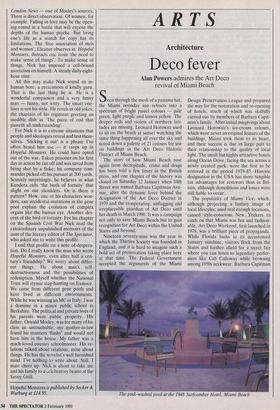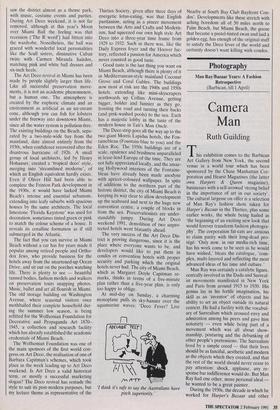ARTS
Architecture
Deco fever
Seen through the mesh of a panama hat, the Miami noonday sun refracts into a spectrum of bright pastel colours — pale green, light purple and lemon yellow. The deeper reds and violets of northern lati- tudes are missing. Leonard Horowitz used to sit on the beach at sunset watching the same thing happening all over the sky and noted down a palette of 21 colours for use on buildings in the Art Deco Historic District of Miami Beach.
The story of how Miami Beach rose again from decrepitude, crime and drugs has been told a few times in the British press, and one chapter of the history was closed on Saturday 12 January when 10th Street was named Barbara Capitman Ave- nue, after the dynamic force behind the designation of the Art Deco District in 1979 and the exasperating, unflagging and irreplaceable guardian of Art Deco until her death in March 1990. It was a campaign not only to save Miami Beach but to gain recognition for Art Deco within the United States and beyond.
Nineteen seventy-nine was the year in which the Thirties Society was founded in England, and it is hard to imagine such a bold act of preservation taking place here at that time. The Federal Government accepted the arguments of the Miami Design Preservation League and prepared the way for the restoration and re-opening of hotels, much of which was skilfully carried out by members of Barbara Capit- man's family. After initial misgivings about Leonard Horowitz's ice-cream colours, which were never an original feature of the buildings, Miami took them to its heart, and their success is due in large part to their relationship to the quality of local light. The small but highly attractive hotels along Ocean Drive, facing the sea across a newly created park, were the first to be restored in the period 1979-85. Historic designation in the USA has more tangible tax advantages for restorers than in Bri- tain, although demolitions and losses were still liable to occur.
The popularity of Miami Vice, which, although projecting a fantasy image of local lifestyles, used real enough locations, caused style-conscious New Yorkers to catch on that Miami was fun and fashion- able. Art Deco Weekend, first launched in 1978, was a brilliant piece of propaganda. While Florida basks in its accustomed January sunshine, visitors flock from the States and further afield for a street fair where you can listen to legendary perfor- mers like Cab Calloway while browsing among 1950s neckwear. Barbara Capitman The pink-washed pool at the 1948 Surfcomber Hotel, Miami Beach saw the district almost as a theme park, with music, costume events and parties. During Art Deco weekend, it is not far removed, although at this year's Moon over Miami Ball the feeling was that recession (`The R word') had bitten into the wardrobe. Nonetheless, the ball was graced with wonderful local personalities like the Scull sisters, diminutive Cuban twins with Carmen Miranda hairdos, matching pink and white ball dresses and six-inch heels.
The Art Deco revival in Miami has been made by people slightly larger than life. Like all successful preservation move- ments, it is not an academic phenomenon, but a human one. The atmosphere is created by the euphoric climate and an environment as artificial as an ice-cream cone, although you can fish for lobsters under the freeway into downtown Miami, since all the water system is pollution-free. The existing buildings on the Beach, sepa- rated by a two-mile-wide hay from the mainland, date almost entirely from the 1930s, when confidence recovered after the disastrous hurricane of 1926. A small group of local architects, led by Henry Hohauser, created a 'tropical deco' style, merging into 'streamlined moderne', of which an English equivalent hardly exists. Even if Oliver Hill had been able to complete the Frinton Park development in the 1930s, it would have lacked Miami Beach's intense and essential urbanism, extending into leafy suburbs with spacious houses by the same architects. The local limestone 'Florida Keystone' was used for decoration, sometimes tinted green or pink to match the colour scheme of a house. It reveals its corallinc formation as if still submerged in the Atlantic.
The fact that you can survive in Miami Beach without a car has for years made it popular among retired people and Ortho- dox Jews, who provide business for the hotels away from the smartened-up Ocean Drive, and sit out on the porches watching life. There is plenty to see — beautiful tanned bodies, fashion models and walkers on preservation tours snapping photos. Music, ballet and art all flourish in Miami. The old storage building on Washington Avenue, where seasonal visitors once mothballed their complete household dur- ing the summer low season, is being refitted for the Wolfsonian Foundation for Decorative and Propaganda Art 1870- 1945, a collection and research facility which has already established the academic credentials of Miami Beach.
The Wolfsonian Foundation was one of the main sponsors of the first world con- gress on Art Deco, the realisation of one of Barbara Capitman's schemes, which took place in the week leading up to Art Deco weekend. Is Art Deco a valid historical term, or mostly a successful marketing slogan? The Deco revival has remade the style to suit its post-modern purposes, but my lecture theme as representative of the Thirties Society, given after three days of energetic lotus-eating, was that English puritanism, acting as a pincer movement between the Arts and Crafts and Modern- ism, had squeezed our own high style Art Deco into a three-year time frame from 1929 to 1932. Such as there was, like the Daily Express foyer and the Hoover fac- tory, reflected a passion for America which never counted as good taste.
Good taste is the last thing you want on Miami Beach, although there is plenty of it in Mediterranean-style mainland Coconut Grove and Coral Gables. The buildings now most at risk are the 1940s and 1950s hotels, extending like mini-skyscrapers northwards up Collins Avenue, getting bigger, bolder and funnier as they go, fronting the road and turning their backs (and pink-washed pools) to the sea. Each has a majestic lobby in the taste of the modern house in Tati's Mon Oncle.
The Deco strip goes all the way up to the two giant Morris Lapidus hotels, the Fon- tainebleau (Fountain-blue to you) and the Eden Roc. The 1950s buildings are of a scale, opulence and brashness unparalleled in lease-lend Europe of the time. They are not fully appreciated locally, and the amaz- ing Hollywood interiors of the Fontaine- bleau have already been made anodyne with apricot-coloured wallpaper. In spite of additions to the northern part of the historic district, the city of Miami Beach is keeping its way clear to allow development up the seaboard and next to the huge new convention centre, a couple of blocks in from the sea. Preservationists are under- standably jumpy. During Art Deco weekend 1991, demolition of two unpro- tected hotels went blatantly ahead. The very success of the Art Deco Dis- trict is proving dangerous, since it is the place where everyone wants to be, and developers would like to put them in condos or convention hotels with proper security and parking which the original hotels never had. The city of Miami Beach, which as Margaret Doyle Capitman re- marks, thinks in terms of a five-minute plan rather than a five-year plan, is only too happy to oblige.
At mid-day on Sunday, a charming monoplane pulls its sky-banner over the aquamarine waves: 'Deco Fever? Live 'I think it's safe to say the Australians have pitch superiority.' Nearby at South Bay Club Bayfront Con- dos'. Developments like these stretch with aching boredom all of 50 miles north to Palm Beach, but Miami Beach, the goose that became a pastel-tinted swan and laid a golden egg, has enough of the original stuff to satisfy the Deco fever of the world and certainly doesn't want killing with condos.



















































 Previous page
Previous page